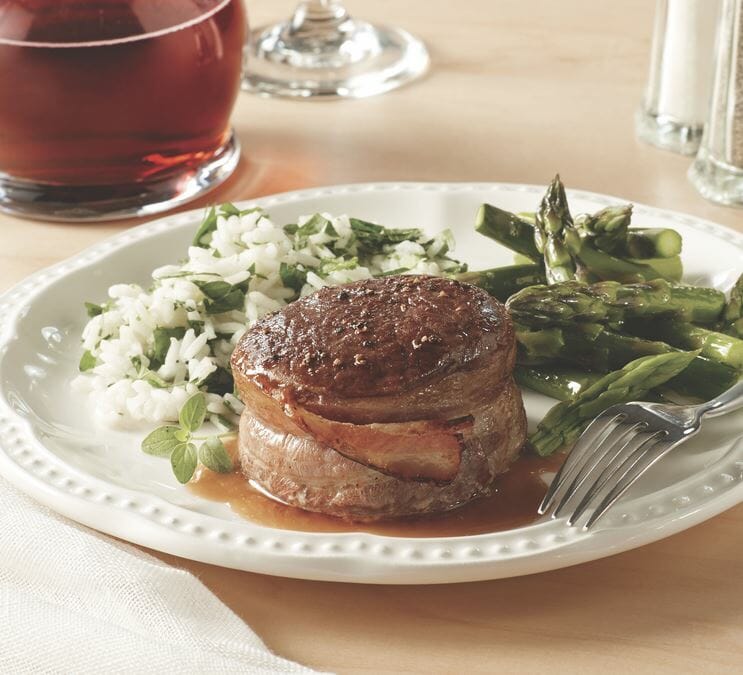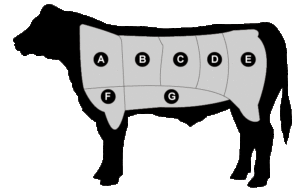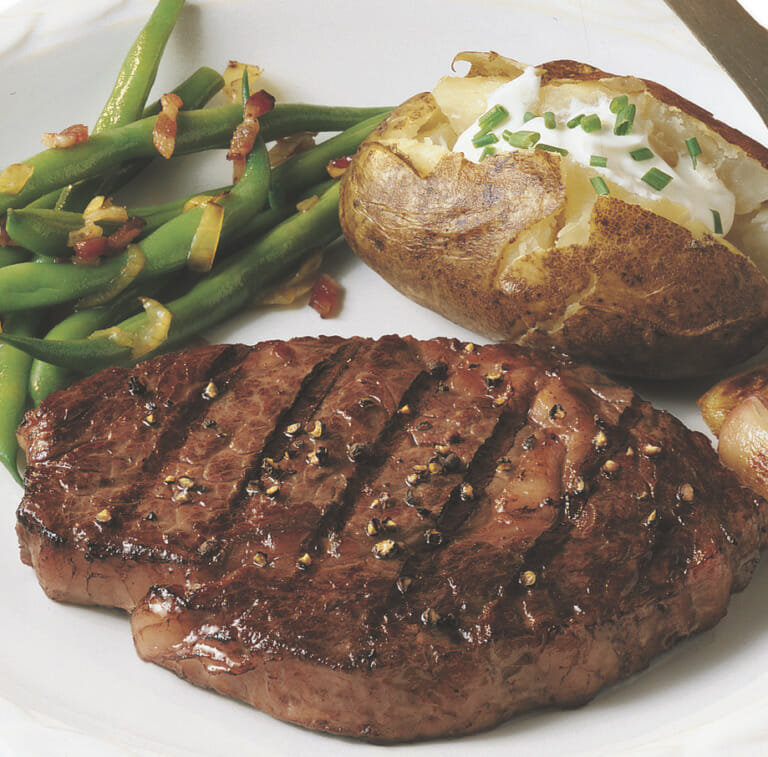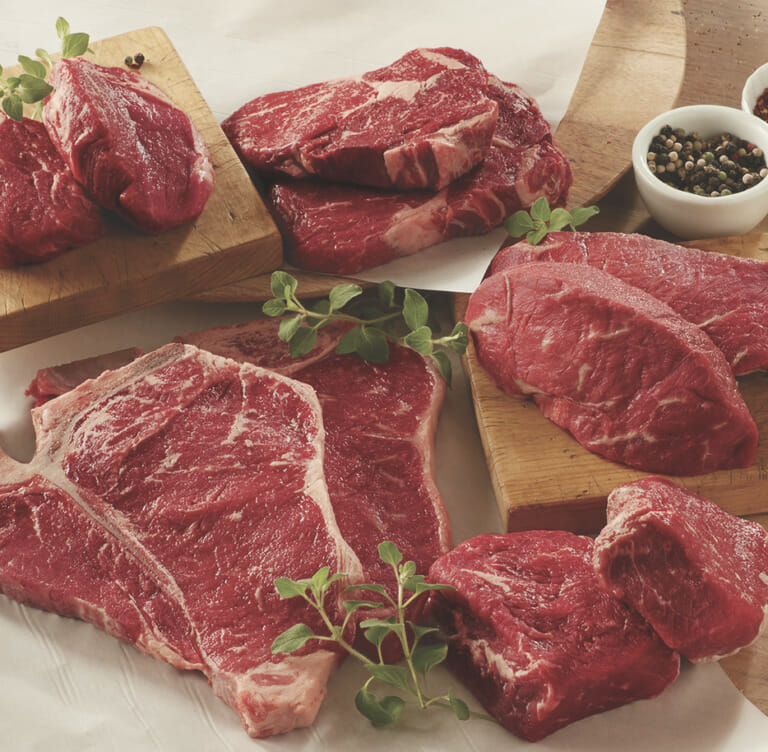Filet Mignon: Try a Little Tenderness
Perfectly aged and bacon-wrapped, filet mignon is the jewel of the beef tenderloin. Learn how to cook filet mignon right and fall in love with this tender little beauty.
So you’re planning a special meal—maybe a cookout—with beef as the centerpiece. You want something that’s sure to impress, and you’re wondering: “What’s the best steak?” The answer, of course, is complicated; it depends entirely on personal taste. But if your main consideration is tenderness, it makes sense to start with the cut whose name says it all: the tenderloin.
The part of the beef tenderloin known as filet mignon has been called the “king of steaks” by many people, but we’d have to give that designation to the mighty porterhouse (which actually includes a filet mignon) on size alone. The filet itself is simply too petite to be called the “king” of anything—maybe one with a Napoleon complex—but its melt-in-your-mouth tenderness is enough to make a grown man swoon.

Anatomy Lesson: What Is a Filet Mignon?
The French have such a way with words…especially when it comes to food. A filet is simply a boneless cut of meat or fish. For some reason, it’s usually spelled “fillet” when referring to fish—or the knife used to fillet said fish—but with beef it’s filet. Mignon is a French word meaning “cute” or “dainty.” Maybe that doesn’t sound like the kind of thing a manly man would throw on the grill for his buddies, but any guy who loves a great cut of beef will happily set aside that machismo and declare his love for filet mignon (pronounced fee-LAY meen-YOHN, without much of an “N” on the end).
And the end of the tenderloin is precisely where the filet comes from…particularly those that are the most mignon.
The tenderloin, or psoas major, is a cylindrical muscle (actually a pair of muscles) running along both undersides of the spine. It is thickest in the middle and tapered at the front end. The thickest part is often used for a luxurious roast the French call chateaubriand. When sliced crosswise into round sections, these boneless steaks are the filets. The larger filets cut from the thickest part of the tenderloin are called tournedos in French, while the smaller steaks from the front end are filets mignons. Most Americans do not use the term tournedos, and apply the term filet mignon to any tenderloin steak. The ends of the tenderloin are not considered steaks, but are sold as “tenderloin tips.” There is no difference in tenderness or quality between the center and the end; it is only a question of size. The psoas major is the least-worked muscle in the body, which is why it is so incredibly tender.
The second-most tender muscle is the loin, located along the spine at the top of the back. This is where strip steaks come from; when both the strip and the tenderloin are left attached to the bone, they form a T-bone or porterhouse steak…but that’s another subject. This is all about the filet.

Buying Filet Mignon
Honestly, it’s pretty hard to go wrong when buying a cut of meat like this…but there are some things to consider.
First, your filets should be evenly cut for uniform thickness, which in turn leads to uniform cooking. Second, they should be professionally trimmed. The tenderloin can have undesirable things on the outside: specifically, silverskin and fat.
The silverskin is a silvery-white membrane on the outside of many muscles. It does not break down in the cooking process, cannot be chewed, and must be removed. Those without decent knife skills may find this difficult.
So what’s wrong with fat, you may ask? Well, that depends. Intramuscular fat (otherwise known as marbling) gives beef that lush, juicy texture, flavor and “mouthfeel” we all covet. External fat is another thing entirely: it’s basically suet for the birds. It’s easy enough to remove, but when you’re paying a premium for filet mignon, you shouldn’t have to do all the work. Skillful cutting and trimming produces a much better steak…and then, of course, there’s aging.
There are those out there who will tell you that filet mignon is overrated. Those people likely have not had one that was properly aged. The most often-cited reasons for their disdain are: 1) there’s not enough fat; and 2) there’s not enough flavor. The first is easy to overcome: Buy at least choice-grade filet mignon, with sufficient marbling to keep it juicy. As for flavor, they do have a point. As mentioned earlier, the tenderloin is the least-used muscle in the body…and what makes it the most tender also makes it the least flavorful. That’s why so many people love a “beefier” cut like sirloin. But proper aging will turn up the flavor substantially, transforming a tender-yet-unexciting steak into an even more tender morsel that dances in your mouth. And if you really want to add flavor and a bit of fat to make things interesting, there’s nothing like a bacon-wrapped filet mignon.
There’s a reason people are willing to shell out big bucks at a fine steakhouse: A hand-cut, professionally trimmed, properly aged filet mignon is truly as good as it gets.

How to Cook Filet Mignon
For starters, overcooking a filet mignon should at least be considered a misdemeanor…but we won’t get into personal preference here. That being said, there are really only three methods of cooking that should be considered: grilling, broiling, and pan searing. Leave the braising and slow roasting to the tough guys; this tender beauty is done in a flash.
Grilling and broiling are really the same thing, except the heat is coming either from below or above. You’re using a hot flame to sear the outside, caramelizing the natural sugars in the meat to create a dark, flavorful crust and seal in the juices. Same with pan searing, except a small amount of fat is used to keep the meat from sticking. Whichever method you use, the theory is the same: high heat, short time. In other words, whatever you’re serving on the side should be done before you start cooking the steak.
Grilling or broiling: Have your flame on high. If you’re using charcoal, it should be glowing red, and you’re grilling directly above it.
Pan searing: Use a well-seasoned cast-iron skillet. Preheat it until it’s smoking hot, then add enough butter and oil (to help keep the butter from burning) to lubricate the pan, and add the steak as soon as the butter is sizzling.
Use tongs to turn the steak, and NEVER use a fork to test for doneness. Piercing the steak will cause precious juices to escape. This helpful guide will help you determine cooking time for filet mignon.
What Wine Goes with Filet Mignon?
As with any cut of beef, red wine is best…but since filet mignon has a lighter flavor and less fat than the “beefier” cuts, many of the big, tannic Cabernet Sauvignons can overpower the meat. Instead, try a more fruit-forward wine like merlot, syrah/shiraz, sangiovese (Chianti) or zinfandel. Softer, rounder flavors can help make up for the lack of rich fat. This is also a nice time to break out the lighter reds like pinot noir or Beaujolais, which don’t have enough tannins to stand up to a rugged, bone-in porterhouse. And if you simply must drink white, make it a rich, buttery chardonnay.
With some perfectly aged filet mignon in the freezer and these simple tips, you’ll be ready to treat guests like royalty.



